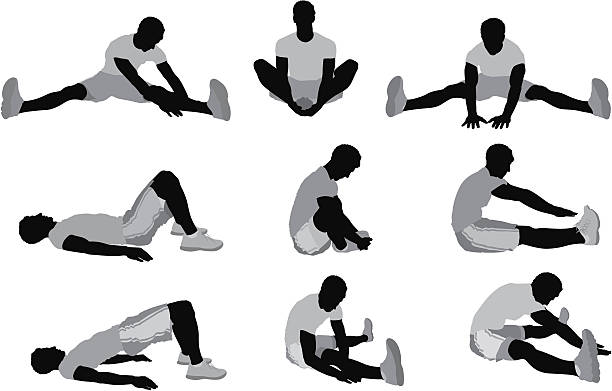Introduction: Debating the Frequency of Muscle Training
Have you ever heard people arguing about how often they should work out their muscles? This is a topic that has been debated for a long time in the fitness world. Some people believe you should train your muscles every day, while others think you should give them a break between workouts. The truth is, the decision on how often to train your muscles depends on your own goals. Are you looking to build mass and strength, or are you simply trying to maintain a healthy lifestyle?
Defining Your Fitness Goals: Quality Over Quantity
The importance of personalized fitness goals

1. Understanding Personalized Fitness Goals
It’s important to have personalized fitness goals because each of us has unique needs and abilities. What works for one person may not necessarily work for another. Determine your goals, and set realistic goals that align with your capabilities. When you clearly understand your goals, you can tailor your workout routines and diets to suit your body workouts and your needs effectively.
2. Prioritizing Quality Over Quantity
Many think the more they work out, the better results they’ll achieve. But this is only sometimes the case. Moreover, having an unbalanced workout routine or pushing yourself to your limits can harm your body. Focusing on quality over quantity will yield better results without compromising your overall health.
3. How to Train for Quality Results
So, how do you prioritize quality over quantity regarding training? Start by setting manageable goals, and allow yourself time to rest. Take moderate-intensity workouts regularly instead of high-intensity ones that can leave you feeling exhausted. Stick to proper form and movement; this ensures you’re engaging your intended muscle group, avoiding injuries, and maximizing your results.
4. The Importance of Nutrition
Balanced nutrition is a crucial component of achieving fitness goals. But eating well doesn’t necessarily mean depriving yourself of your favourite foods. Instead of following restrictive diets, focus on moderation and balance, especially regarding calorie intake. Opt for whole foods that provide essential nutrients instead of processed or added sugars.
5. Enjoy the Process
Becoming fit is a journey that requires patience and commitment. Embrace the process and enjoy it. Try out new routines, invest in quality gear, work with certified trainers, and keep adjusting your goals. Remember to appreciate and celebrate every small achievement along the way.

The Bro Split: Is Training Each Muscle Once a Week Enough?
An overview of the ‘bro split’ method
Pros and cons of training each muscle once a week
What is the “bro split” method?
The bro split is a type of workout routine popularized in the fitness community. This workout routine is characterized by lifting weights, with each muscle group working out only once a week. For example, on Monday, you would train chest; on Tuesday, you would train back; on Wednesday, you would train legs; and so on. This type of workout plan is often followed by bodybuilders who have already developed muscle mass and want to focus on individual muscles.
Pros of the “bro split” method
The bro split method can help a bodybuilder focus on specific muscle groups. Targeting one muscle group at a time makes it possible to focus more on that group, which can lead to more growth over time. The bro split method can also give the muscles more time to rest and recover, leading to better muscle gains. When done correctly and with a healthy diet, the bro split method can help build lean muscle mass and tone the upper body.
Cons of the “bro split” method
Despite the many benefits, there are also some drawbacks to the bro split method. For example, working out a muscle group only once a week may not be enough to produce noticeable growth. The bro split method may also not work well for beginners or those trying to lose weight. Finally, the bro split may need to be more varied for some people who are used to other types of workout routines.
Other factors to consider
It’s important not to follow the bro split method blindly. It’s crucial to consider other factors, such as personal goals, lifestyle, nutrition, and workout preferences. For example, if you want to build muscle or strength quickly, consider other workout programs more designed to achieve those goals. Alternatively, if you prefer to be more active and engaged during your workout routines, choose a workout plan that incorporates more exercises and varied movements.

Training Each Muscle Group Once a Week vs Twice a Week
Training frequency refers to the number of times you work out a particular muscle group weekly. For instance, if you perform chest exercises three times a week, your optimal training frequency for the chest is three times.
Training Each Muscle Group Once a Week – The Advantages
One of the most significant advantages of training each muscle group once or twice a week group is that it allows your muscles to recover adequately. When you work out, your muscles experience “micro-tears,” which need time to heal. Inadequate recovery could lead to injuries or muscle fatigue, and that’s precisely what happens if you train the same muscle group multiple times a week. Additionally, you can perform multiple exercises in a single session, giving you enough time to focus on your form and proper execution.
Training Each Muscle Group Twice a Week – The Advantages
Training each muscle group twice a week could result in better muscle growth than just once. When you work out with weights, the volume of work plays a crucial role in your muscle-building process. Higher volumes done once a week might take a toll on your muscles, leading to burnout. Splitting the volumes over two sessions could result in better muscle release and regeneration, leading to better growth.
Factors That Influence Training Frequency
Certain factors come into play when deciding which frequency is best for you—these factors such as age, genetics, training experience, and nutrition. For instance, if you’re a beginner, start with just once a week and slowly work your way up to twice once per week frequency you’ve built a good base. On the other hand, if you’re genetically gifted to gain muscle quickly, twice a week might be best.
Should I Train Each Muscle Group Twice Per Week?
Training your muscles can be daunting and confusing, especially if you are new to the workout scene. With so many different techniques and routines, it is easy to feel overwhelmed and unsure where to start. One of the questions you may be asking yourself is whether you should train each muscle group twice weekly. This can be a tricky question to answer, as it depends on various factors, including your body type, goals, and current fitness level. We’ll explore this question in detail, examining the benefits of training each muscle group twice per week and when it may be beneficial.
1. Improved Muscle Growth
If you want to build muscle mass, twice-a-week training can be extremely beneficial. When you train a muscle group twice weekly, your muscles are exposed to more stimuli, which can increase muscle growth. By hitting a muscle group more than once a week, you can promote muscle protein synthesis and lead to muscle hypertrophy (muscle growth). Your muscles will have enough downtime to rebuild and recover between workouts, but not so much that they are dormant for an extended period, leading to muscle wasting.
2. Better Recovery
Training a muscle group twice weekly can also improve recovery time between workouts. When you train a muscle group only once a week, you may experience longer periods of soreness and recovery. However, training a muscle group twice per week provides a more consistent stimulus that helps your muscles recover faster, minimizing soreness and the time it takes to recover.
3. Balanced Strength
Training each muscle group twice weekly also helps you maintain balanced strength throughout your full body workouts. If you’re training a specific muscle group only once a week, you may need to pay attention to other areas and, as a result, their strength. By increasing your workout volume to twice per week, you balance training your muscles and increasing your strength overall.
4. Variety and Progression
Training each muscle group twice per week also means you can create more variety in your workouts, which can be mentally and physically beneficial. More variety can help stimulate different muscle fibres and lead to higher training frequency and to more comprehensive overall fitness progress. Additionally, with twice-a-week training, you can progress and push your limits more, leading to higher fitness and strength levels.
5. Potential Drawbacks
While we’ve discussed the benefits of training each muscle group twice per week, it is essential to remember that it may not be the best option for everyone. It is even dangerous for younger or less experienced gym-goers. Some people may already be overcompensating with strength training, so doubling the volume could have you burning out quickly. Additionally, if you have an injury or are not in good physical condition, training twice weekly could lead to injury and impede your progress.

Is it Better to Train Muscles Once or Twice a Week?
A study by the Journal of Strength and Conditioning Research showed that muscle size increases regardless of how many times you train a muscle weekly. However, they found that increasing the training frequency did result in improved muscle endurance and strength gains. If your goal is to build strength and endurance, training twice a week is your best bet.
Another consideration to make when deciding on your training schedule is your level of experience. When you are starting out, it’s best to focus on training each muscle group once a week to ensure proper recovery. As you progress, you can gradually increase the frequency of training. Experienced bodybuilders can train their muscles up to four times a week, but it’s essential to have a well-designed program and allow for sufficient rest between training sessions.
Another important factor to consider is your lifestyle and schedule. Training twice a week might be more manageable if you have a busy work schedule or family responsibilities. However, you can still achieve your fitness goals with a once-a-week training schedule if you perform compound exercises that engage multiple muscles.
It’s vital to note that overtraining is a real possibility and can lead to injuries and setbacks in your progress. When you train too frequently without proper recovery, your muscles need more time to repair and grow. Hence, allowing at least 48 hours of rest between training sessions is crucial.
Practical Considerations: Fitting Workouts into Your Schedule
Whether you are a busy student or a full- body part-time professional, finding the time to engage in physical activities might be challenging. However, there’s no need to worry, as we have put together some practical tips for fitting workouts into your busy schedule.
Tip #1: Create a Schedule
Creating a workout schedule is one of the first steps to take when looking to fit workouts into your schedule. This schedule should fit into your daily routine. Consider the time of day that works best for you, and ensure you set aside a specific time slot daily. Regularly adhering to your schedule can make it easier for your body to adjust to your new routine, and it also helps to build consistency.
Tip #2: Combine Fitness with Other Activities
Incorporating workouts into your daily activities is another smart way to get the most out of your workouts. If you work a desk job, for example, you can take a break and walk or even do some stretches in your office. If you are at home, walk the dog or take the stairs instead of using the elevator. These small changes can help you meet your fitness goals without disrupting your daily schedule.
Tip #3: Try Home Workouts
Signing up for a gym may not be an option for most people, or you might feel too tired after work. The good news is that you can still ensure you get a good workout without leaving your home. Plenty of online tutorials, apps, and YouTube videos on home workouts require little or no gym equipment. They are also cost-effective and allow for much-needed flexibility in your workout routine.
Tip #4: Find an Accountability Partner
Having someone to hold you accountable can go a long way in ensuring you stick to your workout routine. Consider finding a workout buddy, joining workout challenges, or hiring a personal trainer. Knowing that someone else is noticing and rooting for you can motivate you to stick to your workout schedule.
Tip #5: Prioritize Your Fitness
Finally, prioritising fitness is crucial if you are serious about achieving your bodybuilding goals. Always remember that you are investing in your health for the long term. Even when life gets busy, make time to work out. You can also plan your schedule and ensure your workout routine is not interfered with. This ensures your fitness goals take priority and aren’t pushed aside due to other commitments.
The Role of Rest and Recovery in Muscle Growth
Protecting Your Joints During Workouts
It’s essential to focus on the type of workout you’re doing and how often you’re doing it. Overworking your joints can lead to long-term damage and injury, so finding a balanced workout routine is crucial. When you vary your exercises, such as cardio, strength training, and stretching, you give different body parts a break while still getting the benefits of your workout. Remember, taking care of your joints today will help you continue to be active and healthy for many years!
Maintenance Phase: Keeping Your Gains
Have you ever heard of a maintenance phase? It’s a term that’s used when people want to keep their gains after working hard to reach their fitness goals. The idea is to maintain your current level of muscle mass and body weight rather than trying to continue gaining more. You might be wondering why someone would want to do this. Well, it’s because sometimes it’s hard to keep gaining muscle without overworking your body. By focusing on maintaining your current level of fitness, you give your body a chance to rest and recover. Think of it like taking a break after running a long race. You want to give your body a chance to catch its breath before starting a new challenge.

Case Study: Comparing One-time vs Two-time Weekly Muscle Training
Case Study 1: Outcomes of one-time, weekly resistance training training
The study found that muscle growth or hypertrophy can be achieved by training a muscle group once a week. However, the gains were found to be minimal compared to those who trained the same muscle group twice a week. The participants who opted for once-a-week training only saw a 3.2% increase in muscle thickness, while the other group who trained the muscle protein twice a week had a 6.8% increase in muscle thickness. It was also noted that training weekly could result in muscle hypertrophy, but the rate of strength gain is slow.
Case Study 2: Outcomes of two-time weekly training
The second case study discovered that training muscle groups twice a week could significantly increase performance, strength, and hypertrophy rates. In this study, the participants that opted for twice-a-week training achieved a 10% increase in muscle thickness. They also developed their strength much more quickly than those who opted for once-a-week training, and their gains were much greater. In other words, if you aim to increase muscle mass and strength quickly, training a muscle group twice weekly is your solution.
The importance of muscle recovery
Rest is just as important as exercise in muscle growth. Giving your muscles ample time to recover before the next workout is crucial. Participants were given proper resting days in both case studies to avoid overworking their muscles. The participants who trained twice a week had to split their workouts in such a way that one muscle group would have at least 48 hours of rest before performing an exercise that targeted the same muscle. In one-time, weekly, training programs, the muscles were given at least a week of rest before performing an exercise routine once again.
Why training different muscle groups twice a week can be beneficial.
Training major muscle groups twice a week can be beneficial for several reasons. It’s easy to remember your routine since it will only be split into two sessions, giving you more recovery time for each muscle group. It’s also more efficient than once-a-week training. You’ll achieve muscle gains much faster, which can serve as a motivational boost for you to continue your training.
Adapting Your Training Frequency Over Time
1. The Importance of Flexibility in Your Workout Routine
As you advance in your bodybuilding journey, setting goals and achieving them requires flexibility in your training routine. This means adjusting specific elements to ensure continued progress and avoiding workout plateaus that often lead to a lack of motivation.
Modifying your training frequency as your fitness level changes allows you to prevent burnout and injuries and assess which routine or workout is most effective for you. Regularly changing your workout schedule prevents you from getting too comfortable with your routine and allows you to challenge yourself continuously.
2. How to Adjust Your Training Frequency as Your Fitness Level Changes
When adapting your training for higher frequency using, a few key factors must be considered. These include your overall fitness goals, your availability, and your physical abilities.
For instance, if your training consists of high-volume work, a decreased frequency will permit more extended recovery periods to avoid burnout. However, if you’re working towards building endurance, increasing the frequency of your workouts will be ideal to increase your overall training volume.
It’s essential to note that overtraining or working out excessively can lead to muscle fatigue, burnout, and even injury. Ensure that you’re adequately recovering between workouts by allowing your muscles enough rest time to repair, which will aid in building strength and avoiding injuries.
3. Tips for Adapting Your Training Frequency
– Listen to Your Body: Your body is your best guide. If you’re exhausted or tired, it might be time to decrease your workout frequency to avoid burnout.
– Keep a Record: Keeping track of your workouts allows you to assess your progress and determine which aspects of your fitness routine need modification. Track your training intensity, frequency, and duration to identify which changes led to better results.
– Embrace Variety: Vary your workout routine to achieve maximum results. Experiment with different sets, reps, and rest periods to maintain your muscles’ interest and prevent plateauing.
– Seek Professional Advice: If you need help with how to adapt your training frequency, seek advice from a professional to help you create a workout plan that aligns with your fitness goals.
4. Tying it All Together
From our discussion, it is clear how vital it is to be flexible about your workout routine. Modifying your training frequency is essential to maintain your fitness level and achieve your desired outcome. Listening to your body, experimenting with your workouts, and tracking your progress would be best. Adapting your training program to match your fitness level is necessary for every bodybuilder to keep building muscle, stay motivated, and avoid physical injuries.

Conclusion: Finding Your Optimal Muscle Training Frequency
In conclusion, when it comes to resistance training frequency that works best for your body and goals, training a muscle once a week can be enough for some people, others may benefit from more frequent training. It’s also helpful to consider incorporating full body workouts into your routine to ensure that all muscle groups are getting the attention they need.
While training each muscle group once per week may be okay, there might be better options for some. It’s important to remember that everyone’s body is different and will respond differently to training. That being said, research shows that training each muscle group twice per week can lead to better muscle growth, strength, and overall fitness results. Ultimately, it’s up to you to experiment and find what works best for your body and fitness goals. So keep pushing yourself and trying new things – you never know what kind of gains you might make!


Leave a Reply